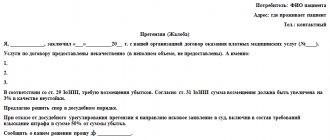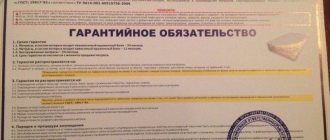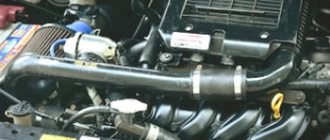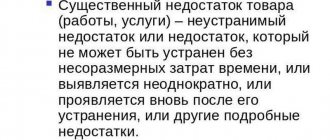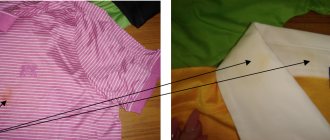Low-quality goods are products intended for sale, but which do not meet the stated parameters, contractual obligations or current standards. Trade organizations enter into contracts for the supply of goods, which reflect all the requirements for them.
If inadequate quality is detected, then there is a certain algorithm of actions when delivering low-quality goods, which allows you to protect buyers and compensate for the seller’s losses.
Norms of the Civil Code of the Russian Federation regarding trade turnover between legal entities
The Russian Federation Law “On Consumer Protection” applies to the relationship between buyer and seller, incl. obliges to ensure the proper quality of the purchased goods (what are the consequences of selling low-quality products under the law?). The buyer has the right to make claims and return low-quality products (read about how to write a claim for a product of inadequate quality here). At the same time, this Law does not regulate the relationship between the supplier and the seller of goods, which are legal entities.
In order to prevent products of inadequate quality from appearing on store shelves and at the same time avoid losses to the seller, there is another key regulator - the Civil Code of the Russian Federation. It regulates the relationship between the parties regarding quality issues, the rights and obligations of the supplier and buyer as legal entities (Articles 309, 310, 475-477, 518 and 523).
The Civil Code of the Russian Federation clearly defines the procedure for the supply of low-quality goods, but to avoid controversial situations, the relationship should be secured by a sales contract.
What does a buyer to whom a defective product was sold have the right to demand?
Based on Article 18 of Law No. 2300-1, the buyer has the right to demand that the store return the full cost of products returned due to the discovery of defects.
Additionally, a citizen may demand payment:
- Compensation for moral damage (Article 15 of Law No. 2300-1);
- Penalty (Article 23.1 of Law No. 2300-1);
- Fine (Article 23 of Law No. 2300-1).
If the item was purchased on credit, the store is obliged to reimburse the client for interest costs.
What are substandard products, and how can this be reflected in the contract?
The agreement between the supplier and the buyer is recognized as the primary document by which disputes are resolved, and therefore should reflect as fully as possible the rights and obligations of the parties and their actions in case of violation of contractual terms, incl. rules for regulating the quality of goods and their return in the event of legitimate claims.
Legislation establishes rules that determine which goods can be considered low-quality. The following options fall into this category:
- Non-compliance with the terms of the contract and the specifications attached to it.
- Non-compliance with current standards (GOST, TU, etc.) applicable to this product.
- Impossibility of use for its intended purpose, although this is clearly stated in the Agreement.
- Inconsistency with generally accepted business traditions, incl. industry recommendations and standards.
- Non-compliance with the sample, if the product is supplied according to it or as described.
- Expiration date or shelf life.
- Violation of sanitary, hygienic and fire safety requirements.
An important point of the contract is the quality acceptance rules . It is necessary to stipulate the mandatory presence of a supplier’s representative, the methodology for checking and assessing quality, and the number of samples to be tested (continuous or random control). In this case, the specifics of the product and the volume of delivery should be taken into account.
For example, poor quality may only be detected after a certain time, during processing or installation of the product. The timing of claims can play an important role.
Unforeseen situations when uncharacteristic defects occur should also be discussed. It is recommended that the contract include a clause on resolving disputes and resolving disagreements out of court.
Determining the warranty period
The warranty period, as a rule, begins from the day the buyer receives the goods (or from the moment specified in the contract). If it is not possible to set such a day, then the warranty period is calculated from the date of manufacture of the goods.
This is also important to know:
How to return a technically complex product
This rule contains exceptions. So, the countdown of the warranty period begins:
- For seasonal items purchased out of season - from the 1st day of the corresponding season (Clause 2, Article 19 of the LPA). The determination of these dates falls within the competence of the authorities of the constituent entities of the Russian Federation. For example, in Moscow, the autumn season begins on September 1, the winter season on November 1, the spring season on March 1, and the summer season on May 1 (Moscow Government Decree No. 466-PP dated July 16, 2013).
- Things that require connection or assembly (washing machines, gas stoves, plumbing fixtures, furniture, etc.), if this is the responsibility of the seller, - from the date of connection or assembly (Clause 2 of Article 19 of the LPA).
- For goods purchased by sample or remotely - from the date of delivery to the purchaser (Clause 2 of Article 19 of the PPA).
In addition, the legislator has established a rule on the equality of warranty periods for the main product and its components, as well as on a unified procedure for calculating them (clause 3 of article 19 of the Civil Code of the Russian Federation and clause 3 of article 471 of the Civil Code of the Russian Federation).
IMPORTANT! The warranty period is extended by the time spent on repairing the product (Clause 3, Article 20 of the Labor Code). The warranty period begins to run again if the seller (manufacturer) of the defective product decides to replace it with a new one (Clause 2 of Article 21 of the PZPP).
What requirements can be presented when obtaining a marriage?
When receiving a low-quality product, the buyer first of all demands its immediate replacement (Article 518 of the Civil Code).
If this legal requirement is not satisfied, then Art. 475 of the Civil Code provides for the following possibilities:
- Reducing the cost of products by eliminating low-quality goods or reducing prices.
- Elimination by the supplier of defects within the period agreed upon by the parties.
- Reimbursement of expenses for eliminating defects.
If significant deficiencies are identified and it is impossible to eliminate them, the buyer has the right to return all goods, terminate the contract and demand a refund of advance payments.
Additionally, the following compensation is provided:
- Compensation for losses incurred (Article 393 of the Civil Code).
- Penalty for late delivery of quality products in accordance with the contract (Article 330 of the Civil Code).
If the penalty is not specified in the contract, then it can be demanded legally in accordance with Art. 395 Civil Code. It is important to remember that when replacing a low-quality product or returning an advance payment, the buyer is obliged to return it to the supplier, and he has the right to demand payment for unreturned products within 3 years.
Return of goods between legal entities
For products that change ownership in one way or another, time periods are defined during which it can be legally transferred to the previous owner.
- Immediately upon acceptance of the product and checking the quality of delivery.
- Warranty period of use, expiration date.
- Thirty days from the date of receipt of the product, if during acceptance it was not possible to conduct a full check of its quality, completeness, and condition of the consumer packaging.
- Until the expiration of two years from the date of receipt of the subject of the contract.
- Reasonable deadlines for assessing the feasibility of a product and characteristics that satisfy the consumer.
Good quality
The law does not contain regulations regarding the return of products for which the buyer has no claims regarding properties and functions. In practice, returning a quality product is very difficult.
Free HOTLINE:
Moscow time 8 (499) 938 6124
St. Petersburg 8 (812) 425 6761
Fed 8 (800) 350 8362
The main obstacle is the lack of conditions for return or exchange in the legislative framework. In some cases, problems that arise are resolved through negotiations between the parties or based on the terms of the agreement.
Poor quality
It is much easier to formalize the transfer of low-quality products to the former owner by proving that defects, damage or other deficiencies were caused to the product before receipt by the organization.
A claim is made against the seller or supplier of the subject of the trade agreement. There is no sample claim statement. The form can be arbitrary, but contain fixed points:
- name and actual data of the organization;
- details of the trade agreement in the field of purchase and sale (supply);
- product name and total quantity;
- established marriage;
- a reasoned requirement to reject a low-quality product;
- separate links to relevant regulatory and legal acts, as well as clauses of the contract that allow the consumer to obtain a quality item in ownership.
In cases where the supplier, when concluding a contract, indicated existing features that reduce the quality characteristics of the product, the recipient does not have the right to use them as a basis for making a claim.
According to the supply agreement
The organization has the right to refuse to fulfill the terms of the contract when delivering products of inadequate quality. You can return the goods to the supplier, except for those circumstances in which the document provides for certain deviations in product quality from existing standards or from the information given in the company’s catalog.
Without an agreement
If the act of purchasing a product was completed without documentary support of the transaction, invoices, incoming and outgoing cash orders, invoices, and paid invoices upon receipt of the product serve as evidence of it.
Important! The buyer is obliged to accept and pay for a product that meets the quality characteristics specified in the text of the contract. Otherwise, penalties are imposed in the interests of the seller. The agreement may provide for the payment of a penalty for violation of deadlines for acceptance of products.
Algorithm of actions for returning defective goods
When receiving a defective product, the correct procedure must be followed to ensure that the buyer's rights are respected.
The step-by-step instructions are as follows:
- When a quality discrepancy is detected upon acceptance of a product, it must be rejected immediately. You must refuse to sign the invoice. It must be marked with the reason for refusal of admission. It is best to photograph the product and attach a copy of the photo to the invoice.
- If the products are delivered by a third party or a carrier, then the buyer is forced to accept the low-quality goods, but a copy of the supplier’s invoice indicates that it was not accepted due to low quality, but was accepted for storage until replacement (return).
Pre-trial settlement procedure
The first mandatory step in satisfying legal claims is to attempt a pre-trial settlement. First of all, all evidence of poor quality delivery is collected and documented. They must make it clear that the failure is the fault of the manufacturer or supplier and not due to improper storage by the purchaser.
If the goods were picked up, it is important to prove that the defect was not caused by transportation. All facts are included in the inspection report and the expert’s report.
The pre-trial settlement procedure must be specified in detail in the contract. In this case, a special procedure for review and quality control is possible.
Collection of evidence of poor quality
If low-quality products are in the buyer’s warehouse, then an inspection (test) is carried out as specified by the contract or standard. Based on its results, specific violations and inconsistencies are noted. Relevant protocols and acts are drawn up in writing. It is advisable to obtain confirmation by photographing the flaws.
The claim is drawn up by the buyer in any form and is immediately sent to the supplier upon refusal to accept the goods. The claim or complaint must contain the following information:
- supplier and his details;
- date of registration;
- identified deficiencies and what they do not correspond to;
- the essence of the requirement (return, compensation, reduction in grade, etc.);
- reference to legislation;
- signatures of the manager and persons responsible for quality control.
We do not recommend completing the documents yourself. Save time - contact our lawyers by phone:
+7 (499) 938-90-37 Moscow+7 (812) 467-37-23 St. Petersburg
Submitting a complaint to the supplier
The document can be delivered to the addressee in person, through a courier or sent by mail. The supplier is obliged to respond to the complaint within 30 days, after which measures can be taken to ensure the appropriate execution of the contract. The collected evidence is attached to the claim. It is necessary to invite the supplier to inspect the defective product, indicating the date and place of additional inspection with the participation of his representative.
Inspection of defects with the supplier and drawing up a report
Upon arrival of the supplier's representative, a commission is organized and a thorough inspection is carried out. It is advisable to include an independent expert (witness) in the commission . The supplier's representative must have a power of attorney to represent the organization and sign documents. Based on the results of the inspection, a report is drawn up in 2 copies.
If any of the commission members disagree, a special opinion is drawn up in writing, which is attached to the act. If you refuse to sign, a corresponding note is made. A copy of the act is handed over to the supplier's representative against signature indicating the date of delivery.
Conducting an examination if the seller does not agree
If an intractable dispute arises between the parties regarding the assessment of the condition of the goods or the identification of defects causes technical difficulties, then a specialized company capable of conducting an independent examination is involved. The choice of such an organization is carried out by agreement of both counterparties.
The expert organization itself sets the date and place of the inspection and calls representatives of the supplier and buyer. Based on the results of the inspection, a report is drawn up. The parties may challenge the experts' conclusions and request a re-examination.
After considering the claim and expert opinion, the supplier must satisfy the buyer’s requirements for the quality of the product. If this does not happen, then further legal action is taken.
Claim procedure
If an attempt to resolve the dispute out of court does not produce a positive result, the buyer can file a claim in court. Disputes between legal entities are considered by the Arbitration Court.
Drawing up a statement of claim
When drawing up a claim, the requirements of Article 125 of the Arbitration Procedure Code of the Russian Federation are taken into account . It should contain the following items:
- Name and address of the court, name and details of the buyer (plaintiff) and supplier (defendant).
- The estimated cost of the claim and the amount of state duty.
- The essence of the claims and evidence of the delivery of low-quality goods. The necessary documents are attached to the application.
- The essence of the buyer's position.
- Links to violated laws and contracts, as well as examples of judicial practice.
- List of the buyer's demands against the defendant.
- Calculation of compensation amounts and penalties. It is drawn up on a separate sheet and attached to the claim.
- Date of compilation and signature of the manager.
We do not recommend completing the documents yourself. Save time - contact our lawyers by phone:
+7 (499) 938-90-37 Moscow+7 (812) 467-37-23 St. Petersburg
When drawing up a document, the following rules should be observed:
- Brief and clear presentation, but with the maximum number of references to legislation and the contract.
- The requirements must clearly comply with the articles of the law (clause 2 of article 125 of the Arbitration Procedure Code of the Russian Federation).
- Any fact of violation must be supported by proof.
- Without appending confirmation of the filing of a pre-trial claim, the claim will not be accepted in court (Article 148 of the Arbitration Procedure Code of the Russian Federation).
The plaintiff, having sent a statement of claim to the court, is obliged to send a copy of it to the defendant. If it is necessary for a third party (witness) to be present at the trial, then a copy of the application is sent to his address. Without receipts for such postal items, the claim will not be accepted.
Mandatory attachments to the statement of claim:
- a document confirming payment of the state duty;
- copies of extracts from the Unified State Register of Legal Entities of the plaintiff and defendant;
- a copy of the registration certificate of the selling company;
- a copy of the order for the appointment of the head of the organization;
- a receipt for sending the claim to the defendant;
- a copy of the claim and a receipt for sending it to the supplier;
- power of attorney for the organization’s representative in court;
- evidentiary documents.
Payment of state duty
When filing a claim, the plaintiff pays a state fee, which is calculated taking into account the amount of the claim:
- for an amount less than 100,000 rubles - 4% of the amount, but not less than 2,000 rubles;
- 100,000-200,000 rubles – 4,000 rubles plus 3% on the amount exceeding 100,000 rubles;
- 200,000-1 million rubles – 7,000 rubles plus 2% on the amount above 200,000 rubles;
- 1-2 million rubles – 23,000 rubles plus 1% of the amount over 1 million rubles;
- over 2 million rubles – 33,000 rubles plus 0.5% on an amount exceeding 2 million rubles.
If it is necessary to terminate the contract, a fee of 6,000 rubles is paid.
Filing a claim and documents
The statement of claim is submitted by a representative of the plaintiff or sent by mail. To speed up the resolution of the issue, it is recommended to use the services of an experienced lawyer.
Trial
A trial in a case of supply of low-quality goods may take place in a simplified or ordinary manner. In the first case, the decision is made without the obligatory appearance of the parties, in case of obvious violations and small amounts of the claim.
The usual process includes:
- Preliminary meeting . It is carried out within 5 days after submitting the application. The judge listens to the opinions of the parties and accepts their petitions.
- Main session . It conducts hearings of the parties with the participation of lawyers. Evidence is provided. If it is necessary to interview witnesses, 2-3 sessions may be held.
It is important to consider that the court does not consider the issue of returning or exchanging goods. It can satisfy the collection requirements:
- payments made;
- penalties;
- compensation for losses and damages;
- legal costs;
- cost of legal services.
Rules for drawing up a certificate of delivery of low-quality goods
If after delivery of the goods a defect or discrepancy is discovered, the seller must draw up a report. This is an official document that is signed by several people. If we are talking about the delivery of defective goods, this indicates a violation of the terms of the contract.
Before drawing up an act, an examination must be carried out to confirm the low quality of the product. Based on the results of the check, the report itself is sent to the supplier. This document is confirmed by examination data and is an official document confirming the claims. On its basis, a legal claim can be drawn up.
A sample act looks like this:
- Date and place of document preparation.
- Details and coordinates of both parties.
- The text of the document must contain the details of the agreement under which there was a violation.
- Next, in the act you need to fill out the main part, in which the detected inconsistencies with the characteristics of the product are stated, the requirements are stated, in what form the consumer expects compensation.
- The act must be signed by both parties and sealed.
Product defects can be presented in the form of a table:
| Name | Delivery quantity | Number of defective products |
| Ceramic mugs | 500 pieces | 35 pieces – visible chips |
| Deep plate | 300 pieces | 11 pieces – chipped |
The act can be either in handwritten or printed form. Each party must have one copy of the form in their hands.
Refund claim
The claim does not have a strictly defined form.
The application is written in free form, but indicating the required details:
- Full name, address, consumer contacts;
- name of the product in accordance with its passport;
- an indication of the circumstances of the return and the reasons for this action;
- request for a refund and acceptable methods of this process.
Receipts are attached to the document. The claim is written in two copies; on the buyer’s copy, the store must affix its details and the organization’s seal with its signature.
The money is returned within three days after the buyer returns the purchased item to the seller. If the store refuses, the buyer can safely file a lawsuit.
This is also important to know:
Claim for poor quality services
Before going to court, the party serves the claim on the future defendant.
It should briefly outline the existing situation and also state the buyer's requirements.
The document must indicate a reasonable period for correcting defects . The applicant writes the same in his claim.
The applicant, having written a claim, can choose the court where his case will be heard: at the place of registration of the defendant or at the place of purchase. If the value of the claim is less than 50,000, then the statement of claim is considered by the magistrate court, if higher - by the district court.
IMPORTANT: applicants for this category of cases do not pay the state fee, since they are exempt from it.
Plaintiffs - consumers have the right to demand from the seller who violates their rights:
- compensation for moral damage;
- payment of a fine for refusal to voluntarily fulfill the legal requirements of the consumer.
Refund if receipt and original packaging are missing
There are cases when the buyer prematurely gets rid of the sales receipt and original packaging. In this case, you should not neglect your consumer rights. The fact of purchasing a product can be easily confirmed based on the testimony of witnesses, as specified in Article 493 of the Civil Code of the Russian Federation.
As for packaging, it is advisable to preserve it for 15 days to ensure smooth acceptance of the goods by the seller.
If the return of low-quality goods to the store occurs later than this period (during the warranty period), then there is no need to preserve the packaging material.
If the sales receipt is lost, the packaging can serve as proof of the purchase of the product in a specific store.
Examination of goods of inadequate quality
It is worth keeping in mind that any seller, if the goods are returned to the store, will order an examination of the goods of inadequate quality - an independent assessment by special experts who can determine what caused the breakdown. If a manufacturing defect is recognized, i.e. a defect, then the seller bears the costs, and the buyer has every right to demand compensation for damage. Returns of goods of inadequate quality are carried out within 10 days. And if the examination gives an answer in favor of the seller, the buyer bears the costs. For example, experts may recognize that the product breakdown was the fault of the buyer - then the product will not be returned, regardless of whether it can be used or not. The result can always be challenged in court. Or the buyer has the right to contact any expert department himself and provide the seller with his results.
